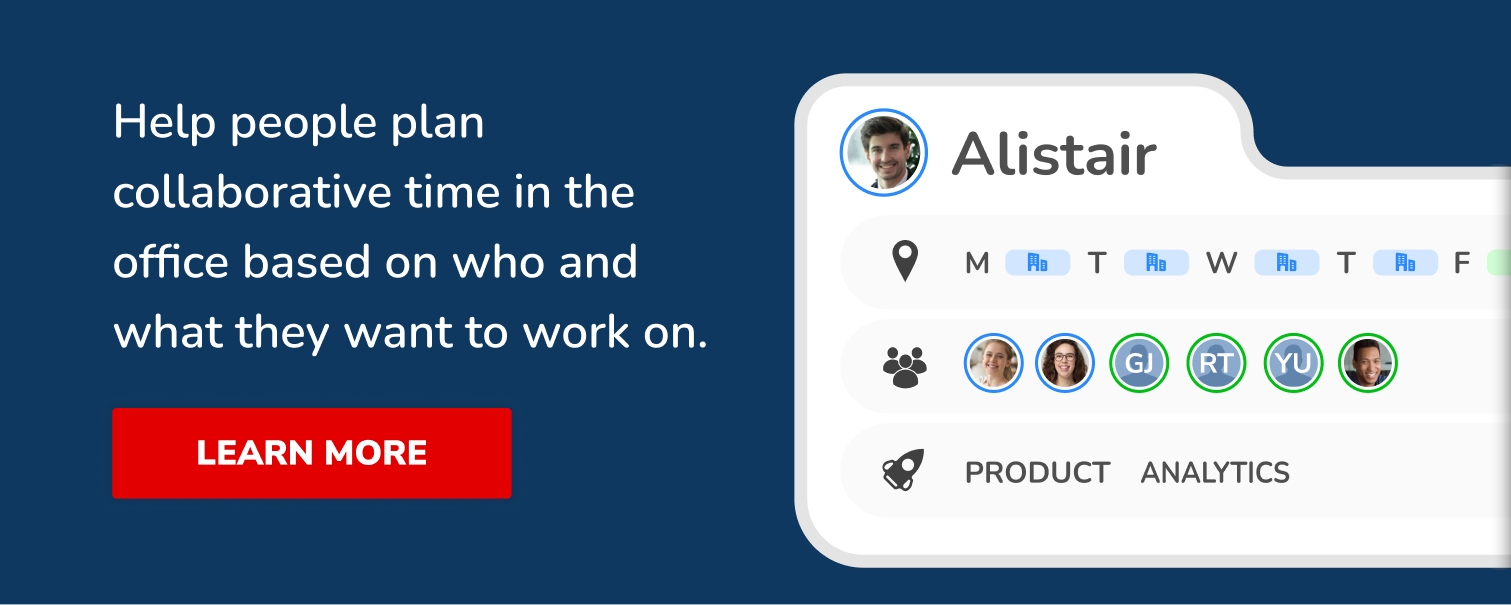Now that hybrid working is no longer a workplace novelty, people are faced with a new challenge. It's not about where to work anymore, but rather about when to work in each of the various locations offered by flexible hybrid working. Should employees be coming into the office on set days each week or should it be up to them? How many days should employees be in the office each week? Are there definitive answers to these new challenges?
Which are the best days to go into the office? The most popular days to come into the office are Tuesdays, Wednesdays and Thursdays, with Tuesday being the #1 preferred in-office day. But most popular doesn't alway mean best.
Today, most people enjoy some variation of homeworking, office work, co-working spaces, and even the occasional coffee shop. Deciding when to go into the office and when to work from home can have its challenges, depending on different factors such as personal preferences and company needs. 88% of hybrid employees prefer 3 days or fewer in the office per week, with 1/3 preferring just 1 day per week.
While the flexibility and positive impact of hybrid work are undeniable, I’m hearing more and more about the difficulties people have in coordinating when to be in the office with co-workers.
Meetings get scheduled and sometimes rescheduled because somebody ended up in the wrong place, or life happens and causes some miscommunications across the team. Unfortunately, the challenges of hybrid work scheduling tend to grow exponentially as teams get bigger and more distributed.
We've tackled this challenge head-on, and put together a quick guide below to help you navigate the pitfalls of deciding which days to bring people into the office, looking at it both from employer and employee perspectives.

People’s Preferences For When To Work In The Office Fall Into Two Groups
For as long as people have worked the office environment has had two types of employees: those who put their heads down and those who enjoy the social interactions of the office. This is human nature, so people now choose to stay at home or come into the office for two main reasons.
1. Employees Primarily Motivated By Productivity or Tasks
These people may like to work in quiet places where they can focus on the task at hand. For employees who are motivated by productivity, it's best to spend time at the office when they can work on meaningful projects with the right mix of people to help them get their work done.
2. Employees Primarily Motivated By Other People or Networks
This group of employees like to socialise, and they perform best in collaborative environments where they can bounce ideas around in a shared space. For these people, it's best to be in the office on days that are likely to lead to networking encounters, and during key stages of projects where brainstorming will benefit their work.
Read More: 6 Collaborative Meeting Ideas
Which Are The Best Days To Go Into The Office?
The most popular days to come into the office are midweek days, with Tuesday being the most popular followed by Wednesday and Thursday. This is according to a 2022 study of over 50,000 UK employees by hybrid work consultancy, AWA. The office is likely to be emptiest on a Monday or Friday.
From an employer's perspective, preferences differ on the best days to come into the office. Generally speaking, it's widely accepted that people are most productive on Mondays and Tuesdays, with 20.4% of tasks completed at the beginning of the week, on Monday. Productivity often tapers off from Wednesday onwards until it all but disappears over the weekend.
Workplace behavioural studies have also shown that people become more friendly to work with as the week progresses. Thursdays are the most likely day that employees will feel sociable, and Fridays are most likely to feel relaxed if somewhat less productive.
As the research shows, there is no definitive answer to deciding which days to ask people into the office, as it will depend on the organisation’s reason behind wanting people to come in. A company with productivity issues might want to ask people in at the start of the week whereas a company struggling with retention could choose to ask people in on a Thursday or Friday for social bonding activities like post-work drinks.
What Is The Best Day To Work From Home?
According to a 2022 survey, Wednesday is the best day to work from home for hybrid workers.
28% of employees preferred working from home on a Monday, and 25% on a Friday but 30% of survey respondents chose Wednesday as their favourite WFH day.
Employees enjoy the feeling of an extended weekend by skipping the dreaded Monday morning commute or being able to start their weekend slightly earlier by working from home on a Friday.
If a flexible hybrid work schedule isn’t an option for your organisation yet, then it would still be wise to listen to feedback and allow for either a Monday or Friday as work from home to win favour with your team.
The Problem With Fixed Hybrid Work Schedules
Fixed schedules of the same people coming into the office on the same days won't work long term. Some people won't overlap and making everything fixed misses the dynamic nature of our work.
As the research shows, there's no mould for which days are best, so successful companies are now looking towards their own employees to set preferences about when they should be in the office with various hybrid work schedule options being introduced.
PwC's 'flexible work deal' offers employees blended work, flexible location days, and empowered days to tailor the content of their day to suit their workload for both part-time and full-time schedules. Line managers use direct reports to determine what's working, and what's not so that teams can best establish themselves with an optimised workflow.
For some people, Wednesdays and Thursdays in the office bring good opportunities to be around people, while others enjoy starting the week in a productive office and finishing their week from the quietness of home.
For part-time employees, a three-day work week comprising Tuesdays, Wednesdays and Thursdays is considered the best schedule. This complements the new research coming out in favour of a new cultural shift to the four-day work week.
In 2022, 70 UK-based companies took part in a six month trial to switch to a four-day week and the results showed that the majority of employees were keen to take Friday off, or Monday.
How many days in the office is ideal?
There is no definitive answer to how many days in the office are necessary to run successfully as a business, but studies suggest that a minimum of 1.5 days a week is best.
Although plenty of research has been done into all facets of hybrid work schedules, with apparent answers for everything, it’s important to note that every company is different.
More importantly, every employee is an individual with their own preferences and will adapt differently to hybrid workplaces.
Ironing out the best days to have people come into the office is about finding out what real people actually need and then tailoring the company’s hybrid workplace strategy.
Some employees might need extra face time with senior leaders and those whose skills they wish to learn from. These people benefit from having more days in the office, so they can learn by osmosis surrounded by experienced people who come and go around them.
Other people may need social interactions, opportunities for team building, and a space to collaborate in person. These people may be able to spend less time in the office, so they can re-energise themselves for a short period before heading home to focus on getting the job done.

Should Everybody Come Into The Office On The Same Days?
Deciding who comes into the office and when will depend on who is in your team and what they are working on. Some people need to work together regularly in person, so these people should align days where they can expect the right level of collaboration.
Other team members in the same team may be able to contribute remotely, or even work better remotely. These employees can often just come into the office on days when their input is needed.
Read More: How To Organise A Remote Department
Projects and personal preferences should dictate when people come into the office. This allows employees to plan their time accordingly and prevents people from missing out on important collaboration days.
Not all projects are the same, and not all stages of projects require the same level of collaboration. The needs of the work week should define how and where the week is worked, instead of just forcing people's workloads into a fixed weekly schedule.
Use The Right Software To Schedule Hybrid Teams Effectively
There's no easy formula to schedule a hybrid team, and Excel sheets can only get you so far. Some people want to come into the office two or three days a week, while others prefer to work in the office every day, or only occasionally. There are many different ways to decide on the optimum hybrid schedule for your team so take the time to understand what they are and what you think will work for you.
Likewise, meetings and projects change throughout the year. These interactions often need to bring people together strategically to use everybody's time in a cost-efficient, productive way.
Advanced hybrid work scheduling software goes beyond the scope of ordinary planning. Companies now have the technological capabilities needed to sync workflow, coordinate employees' workplace locations by project, allow for fixed days in the office, and tailor large-scale rosters to maximise output for greater productivity.The secret is to remain agile, so you can adapt easily to the changing needs of your people. Book a free tour to see how easy it is to simplify your hybrid work schedule today.
About Author
Graham Joyce is co-founder of DuoMe, a flexible working advocate and a frequent panellist/commentator on the issues of flexibility or hybrid working.







